Mekton Zeta by Kwyndig
An anime world that is never referenced again
Original SA post
Okay, so we doing this:
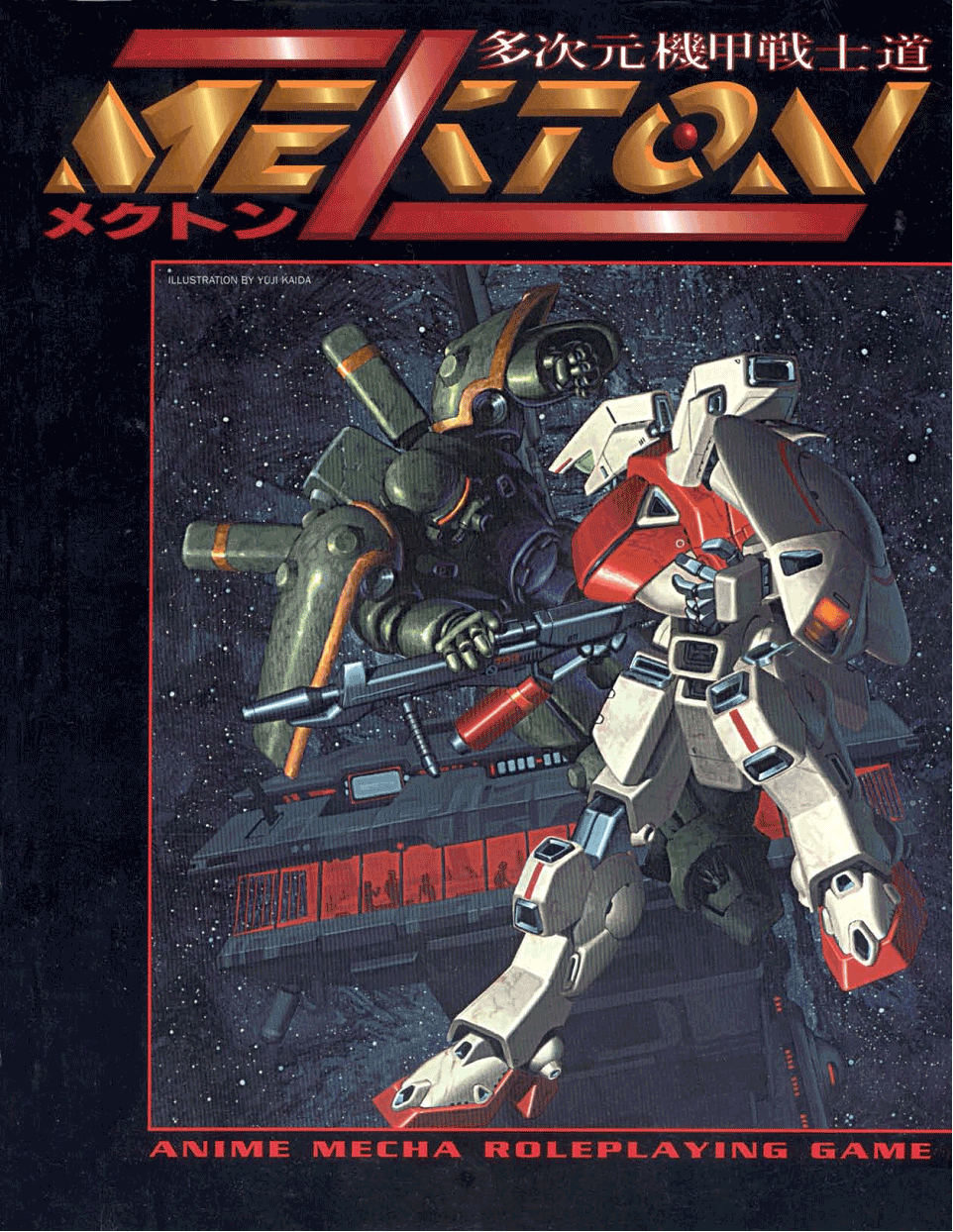
How I learned to stop worrying and love the Bishonen. Mekton Zeta (And Plus, if I get around to it)
Part One: An anime world that is never referenced again
So, Mekton Zeta, the sequel to Mekton II, is an Interlock (the predecessor to Fuzion and the same system the original Cyberpunk 2020 used) system game. It had numerous mechanical problem but we'll get to those. First, that cover piece, by the actual Japanese artist? (Specifically the guy who did awesome painted box art for Gundam Model Kits back when they still used those) Yeah, enjoy that cover art, the rest of it is straight out of how to draw Manga books. Although considering the age of Mekton Zeta, it predates most of them.
I'm just going to say this upfront, when you have your writers (the following pieces are credited to Mark Schumann, one of R. Talsorian's writers according to what info I could dredge from the mists of time) do your art, either you have people in the wrong careers, or something has gone wrong with your company. Now, I'm not going to reproduce all of the color insert pages, just the four I found most ridiculous.
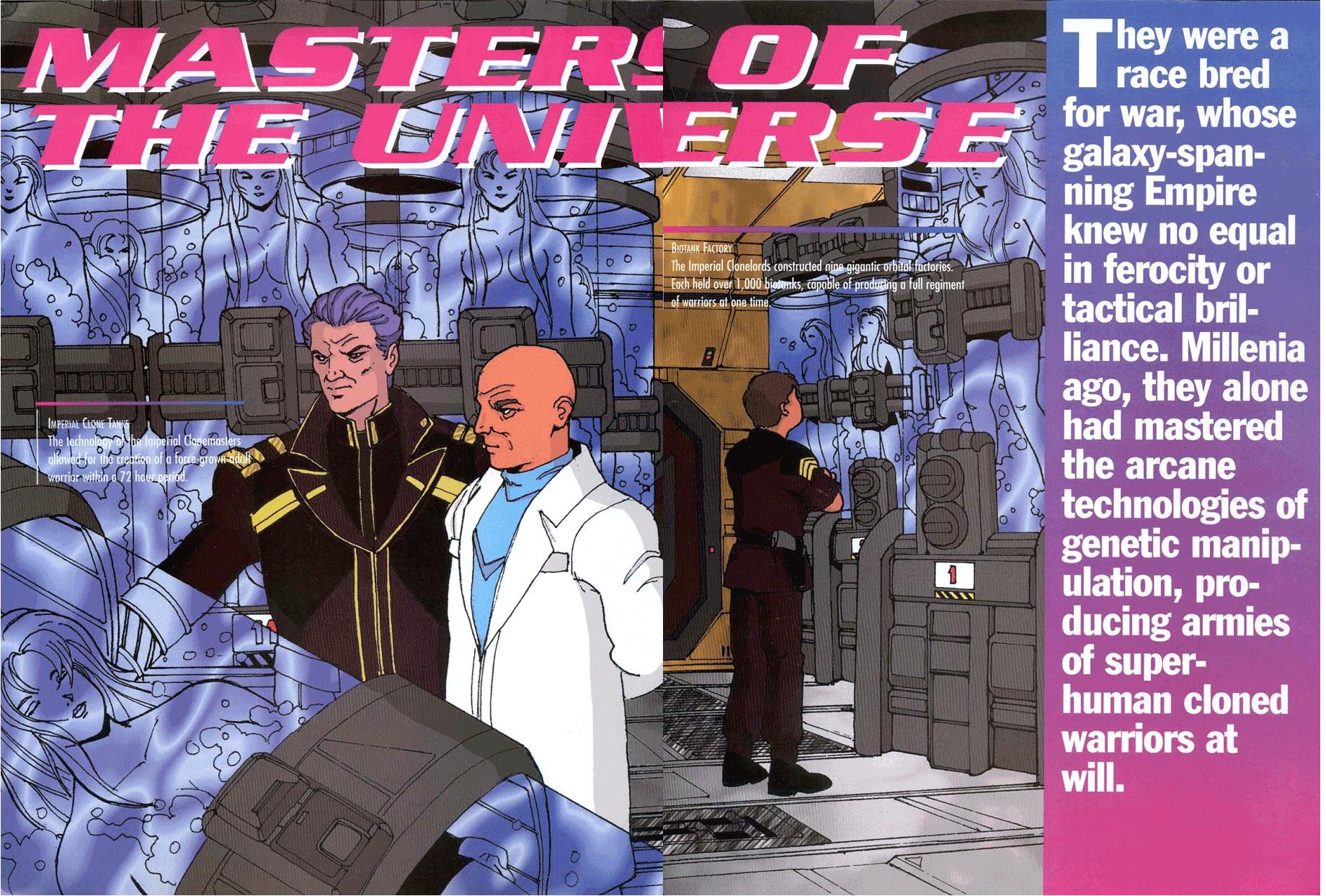
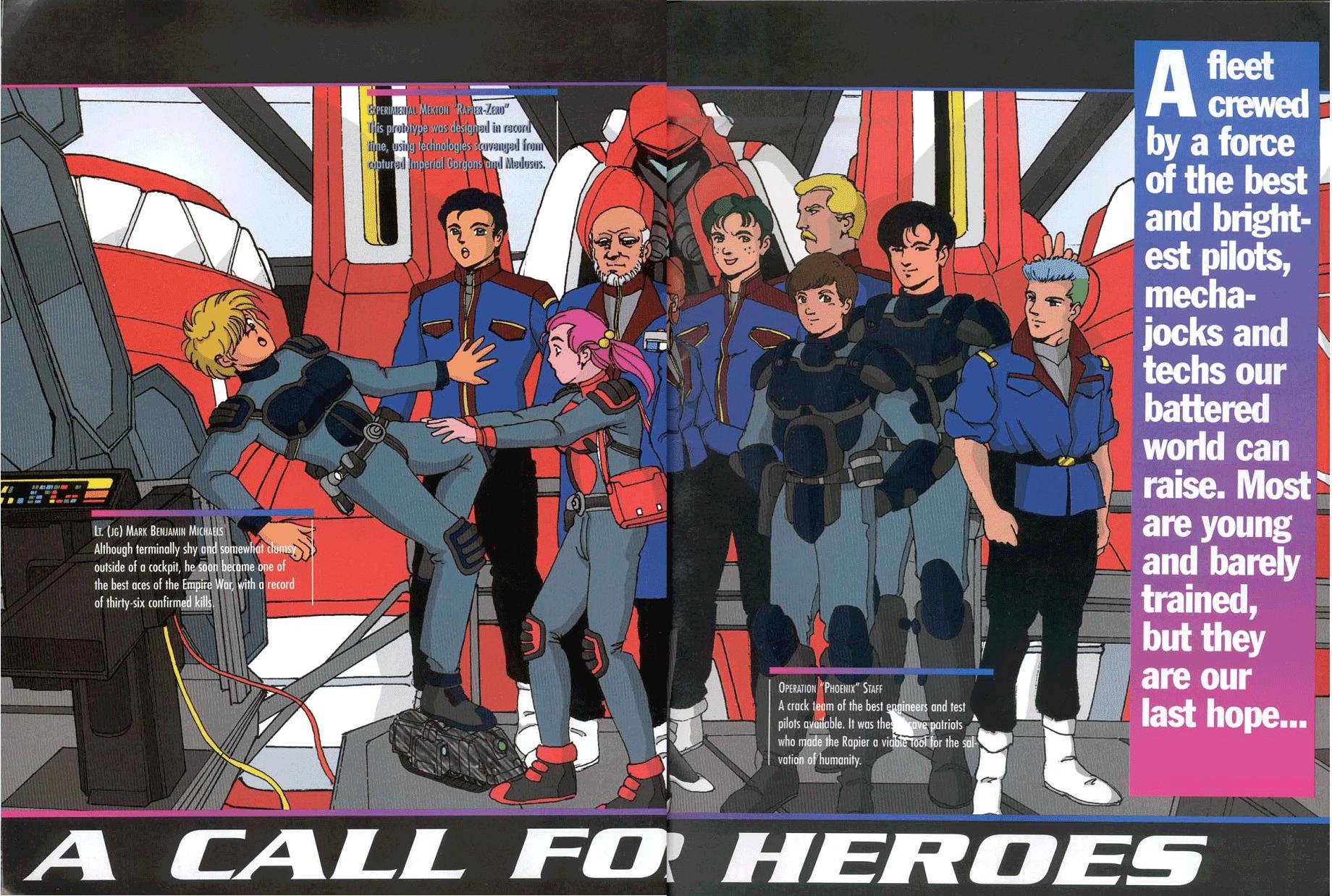
Now, these images might imply there is some sort of plot or metaplot to the game... Nothing of the sort. While there is an Empire mentioned in both of the 'worlds' at the back of the book, they have nothing to do with invasions and cloning (and, from an image I left out, Gundam-inspired outfits (Zeon for the 'bad guys' and Earth Federation for the 'good guys'). The actual writeup for this stuff, as far as I can tell, is in another book entirely. Which is not referenced at all in the first printing as even being a planned product (and the book in question, Invasion Terra, is mostly just a big set of scenarios for wargaming).
edit by Yawgmoth's request: Here is the ripoff Gundam art page:
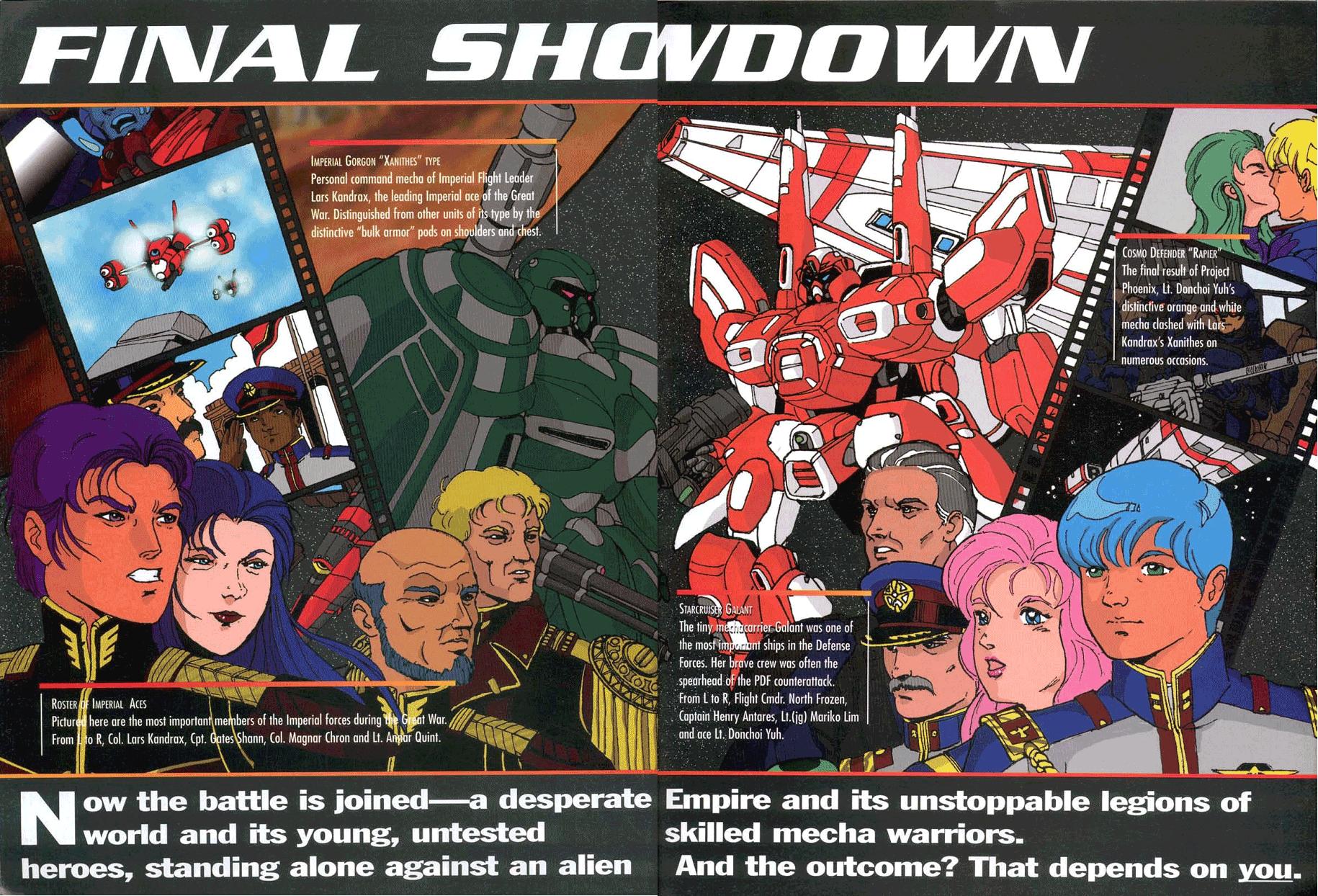
Oh also, as an aside, the last printing of the game doesn't have that cover, or a color insert, mostly because R. Tals doesn't have any money these days, although latter printings do actually have stats for the characters you see on those pages, and supposedly, errata (which isn't actually present!)
So we're off to a great start already. After we get through the terrible art (don't worry, there's more) we make it to the introduction. Which is a brief (and terrible) description of anime.
Mekton Zeta posted:
Welcome to Mekton Zeta, the anime mecha roleplaying game. Within these pages you will discover a new world of gaming: roleplaying the in the worlds of Japanese animation, also known as anime .
With Mekton Zeta, you'll enter.
All this... and giant robots too!
- A world where a 16-year-old kid can steal a top-secret military prototype, be allowed to keep it, and go on to win the war for the good guys.
- A universe where princesses can (and often do) fall in love with very common commoners.
- A place where your enemies always come back to haunt you, and where love is so deep that people die for it.
And that's it for the first twenty-ish pages of the book. A teaser for a book that isn't referenced and wasn't really worth publishing if the reviews are to be believed (I don't have a copy but I suppose I could get one).
Next time: You rolled HOW many siblings? Character Generation and Lifepaths!
Randomly Determining How Many Friends You Have, and whether your parents are spies!
Original SA post Mekton Zeta Part 2: Randomly Determining How Many Friends You Have, and whether your parents are spies!So, now that we've got the introduction out of the way, we're moving on to the first chapter, Character Generation. Everything up to skill selection in Mekton can be randomly rolled, and in some cases must be randomly rolled.
The first step in the character generation process is the Lifepath. While at points on the Lifepath, which is intended to cover the character's life from birth to age 16, you are allowed to chose results, I will be rolling everything. Why? Because all of the things that can fuck over your character require you to roll anyway.
We start by rolling for our hypothetical character's social status. This primarily covers how much cash you start with, but since you aren't expected to actually buy your robot I'm not even sure why the game has money rules. I go over to irc and ask my faithful dice bot to roll a d10 for me. We get a 9, which is good, because on this chart, higher numbers equal more money, in this case we start with 900.. wait, is this yen? 900 yen won't even get me a decent sandwich in the real world. I guess in the future of Mekton Zeta Japan took over the world's economy and experienced a hyper-deflationary period or something.
Anyway, my hypothetical character is apparently a Noble or just plain Wealthy, depending on the world.
Now let's find out if hypothetical character's parents are still alive! We roll another d10 and get a 4. This means something happened to them. Now, the next chart is the first one that specifically says we're allowed to chose, but I'm randomly rolling everything, so here goes. We get another four... which means our character's parents have amnesia ... somehow. Alternatives are several choices for dead parents (war, murder, accident) and several other options where your parents are missing or otherwise not in the scene. If you're wondering where 'regular parents' is located, it's on the previous chart.
Now, having determined that both or one of Hypothetical's parents have amnesia (the game does not specify how to pick this, I guess you just get to chose. I'm going to go with both because that's funnier). We move on to Family Standing. Rolling another d10 (there's a lot of d10 rolling, and again you don't get to pick) we discover that despite having no memory of Hypothetical, everything's otherwise fine.
So we get to skip chart C, which includes such fun things as exile, imprisonment, murder, economic collapse, and other disasters. And we also skip chart D which is where you randomly determine what you're going to do about your family's exile, murder, etc. Actually, charts C and D are both choice charts.
Anyway, now it's time to figure out how many siblings Hypothetical has! And we get six, which means we have six siblings (it's roll a d10, 1-7 is number of siblings, 8-10 is only child). Then we are required to roll for gender, age relative to character, and then chose or roll how they feel about you. It is theoretically possible to be an octuplet. Now, Hypothetical has four brothers and two sisters, one younger brother and sister, and the rest are older than Hypothetical. The younger brother hates Hypothetical, and most of them are evenly split amongst like and dislike (seriously, it's a lot of rolls for something that might not even come up in play, especially as this step is done after finding out whether any of the character's siblings are even alive ). Interestingly, none of them are neutral towards Hypothetical.
It breaks down like so for those of you who care.
-
Brother. Younger. Hate
-
Brother. Older. Hero Worship
-
Brother. Older. Like.
-
Sister. Older. Hero Worship.
-
Brother. Older. Dislike.
-
Sister. Younger. Dislike.
Now we roll for friends, and get a 6, on a d6. Damn the dicebot wants me to do a lot of work tonight. So I tell it to roll 12d10 and figure it out from there. Note, you are not able to pick the friend's gender or relationship to you, this is a roll only chart. Oddly, while the previous chart used odd for male and even for female relations, the friends chart reverses that for no apparent reason.
-
Girl, like a foster parent
-
Guy, someone who grew up with you
-
Girl, teacher or mentor
-
Guy, like a younger brother
-
Guy, teacher or mentor
-
Guy, partner or coworker
It should be noted that ex-lover is also on this chart, so the game can decide your character's sexual orientation for you as well, unless you were just 'experimenting'.
Now we get to Enemies, which you usually don't get at this stage (you can, but it's rare). While we didn't roll an enemy I will still cover the chart. The Enemies Chart lets you chose most of the options, except for why your enemy is mad at you, which includes a Mystery (GM's choice) option, which is always nice to see.
Now we get to Romantic Life, as sixteen year old pilots apparently get all sorts of action. This is another choice chart, but there's only three options and only the subchart for not in a relationship has any kind of choice element to it. To be fair, the vast majority of die rolls will land the character squarely in uninvolved, but that's not what I got. So it's time to more on to chart H1, Ah, Love... and I get a romantic rival for one of the two people involved in the relationship. Oddly, there are no details about either the rival, or Hypothetical's young love, leaving all of this up to player's choice.
We're almost done with Lifepaths (for now), as the game gives us some suggestions on appearance and personality. This is another choice chart, thankfully, but I'm gonna keep rolling. The game recommends only using this chart randomly when rolling friends/lovers/enemies (okay, it might have been nice if they had told us before this step to do that... Not going back because I would have to roll ninety-one more times to populate all the incidental characters we've picked up along the way so far, not counting amnesiac parents).
Anyway, Hypothetical has long blonde hair with bangs, violet eyes, is arrogant, proud, and aloof, values honesty, has a tool of some sort as most valued possession, and values a public figure most in the world. The hair color and eye color chart is full of anime options like green hair and gold eyes. Although violet is a little odd, at least it isn't Always Changing.
Now that we're done with Lifepaths for now, we move on to the next step. Determining stats. Characters have nine stats in Mekton Zeta: Attractiveness, Body Type, Cool, Empathy, Intelligence, Luck, Movement Allowance, Reflexes, and Technical Ability. Most of them are useless unless you spend a lot of time outside of your mecha. Of note are Body Type (which determines you 'Hits', hand to hand damage, encumbrance, etc. it's basically GURPS Strength), Luck (which gives you a pool of points you can spend on rolls) and Reflexes (used for basically everything combat). Of the nine stats, the ones to powergame, if you were into that sort of thing, are Intelligence, Luck, Reflexes, and Technical Ability, everything else is either for social skill rolls or is used to derive something and then never referenced again. Stats have a minimum of 2 and a maximum of 10 (this will be important later).
Now, we get to figuring out how to buy our stats. There are three methods, only one of which is sane, and it's not the recommended option. The first method is to just roll 1d10 for each stat, rerolling any 1s and rerolling entirely if you end up with a total below forty, you have to do this ten times because I didn't mention Education, which is a 'substat' in that it's not actually a stat but you buy it during stat generation.
The second method (listed as the default) is to roll 10d10 and then take the total to split amongst your stats as you desire. Again, you reroll if you get below 40. This method, from a game design standpoint, pretty much combines the two worst features of random generation and point buy, and it's the default . Let me repeat that, the game wants you to randomly roll for how many points you get to build your character. As the most insane option, I will of course be using it.
The final option is to have the GM decide how many points everyone gets to build their character. The game recommends 70 points, but it also lists other options from 55 (slightly worse than average) to 80 (practically superhuman).
This post has gotten pretty long, so I'm going to leave you with a few pictures from the book and a chart I didn't get into.
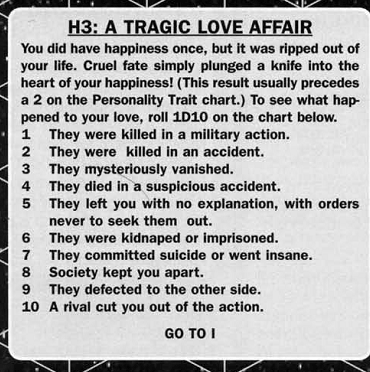
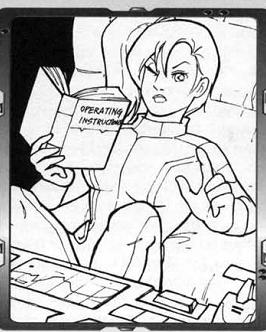
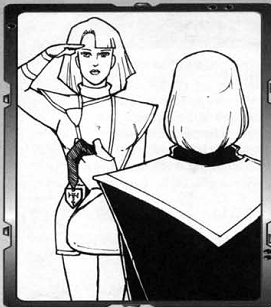
Next time: Skills? And maybe resolution mechanics!
How Did You Lose Your Arm Working as a Game Designer?
Original SA post Mekton Zeta part 3: Stats, Skills and Professions, Character Generation Continued, or, How Did You Lose Your Arm Working as a Game Designer ?Okay, picking up where we left off I rolled 10d10 for character points, and got 56.
So, being the crazy little munchkin that I am, I arranged them as follows. I could split them up and get an average of 5.6 but that's just terrible, as my character actually would be below average in everything (average is 6 except in EDUcation, where it's determined by how long you went to school, which for a 16 year old character is realistically a 2, but who cares about realism?)
Instead, I'm going to max out the most broken stats and put a pittance in others, then describe what the result would actually be for a real person.
-
ATT 2
-
BOD 4
-
CL 4
-
EMP 2
-
INT 10
-
EDU 10
-
LUCK 6
-
MA 2
-
REF 10
-
TECH 6
What we have here is an ugly, weak, hot headed, unable to relate to normal people genius with multiple Doctorates, peak human reflexes, and who can run 4 meters in a turn (ten seconds), which puts them clearly in the 'easily winded' category combined with their overall physical fitness.
But Hypothetical here does get maximum skill points and starts with the all-important 10 in Reflexes. Sure, Hypothetical can't take a hit, but that doesn't matter because if we put some points into the Dodge skill pretty much nobody can hit them on foot. Also we're rich so we might be able to afford some decent armor.
Anyway, now that stats are determined we need to look up some derived stuff. So, to start with, I want to talk about Mekton Zeta's health/damage system. While personal weapons use random damage, everything else in the system is fixed values, expressed in either Hits (human scale damage) or Kills (mecha scale damage). Now, this may trigger some reader's Palladium sense, and they'd be absolutely correct. Kills are the MDC of the setting, but at a slightly less insane conversion ratio. It is 25 Hits to a Kill, which means that while most mecha weapons will splat a human, you can theoretically survive a single Kill hit with some body armor.
So, that said, let's find out what Hypothetical can do here. Mekton Zeta uses hit locations for everything . So we need to record the Hits that our Head, Torso, and Limbs separately, consulting the chart we get 5 Hits for our head, 10 for our torso, and 7 for each limb. Most weapons will make short work of that, have I mentioned yet that Mekton Zeta is really fucking lethal if you aren't geared properly? Because it totally is, most personal weapons do multiple D6 Hits in damage, and, as mentioned before, mech weapons do Kills instead. Anyway, now that we've discovered that stiff breeze can cripple our Hypothetical, we discover that his Stun is 5 (which for some reason is a roll-under), he lifts 60 kilos, can throw things up to 12 meters, and has a -1 to all damage rolls with melee weapons. Also he divides carried mass by 2 and then subtracts that from his MA for encumbrance, which means that if carries more than 3 kilograms at a time he can't move at all! I guess that precludes any serious armor or heavy weapons.
Hypothetical also has a Stability score of 10, which is a kind of static difficulty roll for social skills if you don't actively resist them. Which means he's kind of a pushover.
Now on to skills! As I mentioned, he gets the maximum skill points because he has maxed EDU and INT scores, which is 30 Skill points for a 16 year old character.
 And these are all the skills in the game. They're fairly straightforward, the name of the skill is usually description enough. Human Perception is basically the Insight skill from 4e, Programming covers hacking, and at +10 Medical 'you can even cure a rainy day'.
And these are all the skills in the game. They're fairly straightforward, the name of the skill is usually description enough. Human Perception is basically the Insight skill from 4e, Programming covers hacking, and at +10 Medical 'you can even cure a rainy day'.
Some skills are marked (H)ard. This just means you can't buy them above +5 with your starting skill points. That's literally all it means at this point, because hard skills don't cost more at character generation. So, of course we go all in and buy all five mecha combat skills at +5, spending most of our points. We split our remaining five points between Zero-G and Mecha Tech (3 for one, 2 for the other). Normally if you were to powergame you would just buy the attack skills for the kinds of weapons your Mekton uses, but since I haven't decided yet, we're doing this.
Oh, but we're not done yet! You see, at this point we have two options. We can either cash in now and pick a terrible starting dude template consisting of an anime cliche (like Anime Stud, Big Guy, or The Kid), some small skill bonuses, some gear, and a pitiful boost to our starting cash. Or we can go all in and pick up some Professions.
Now, there is a drawback to being Professional, you advance slower, but in return you get more skills and money, possibly friends and contacts as well. You also get older. Every time you pick a Profession you spend 2 years at it, and have to roll on the Expanded Lifepath table, depending on which ones you pick. Certain Professions are marked (D)angerous, which means you roll on the chart with a greater chance of mishap. Game Designer is listed as one of them (it's a joke selection, most of the skills on it don't actually exist except maybe as Expert specialties). Every time you pick a profession, you get +1 to five of the seven listed skills (your choice) and a pitiful 2D10 extra money. We can keep taking professions until we're either barred from everything we want to take, reach age 30, or develop a bout of sanity after rolling on the accident table a few times, whichever comes first.
To start, Hypothetical is going to spend a tour as am EMT (D), first off we note which five skills we want, we're going to take Medical, Jury Rig, Driving, Demolitions, and Photography. We didn't have any of those, so we learn them all at +1, the beginner level. We make an extra 10 (consulting the equipment chapter it turns out these are generic 'credits' so I'm going to refer to them as Spacefun Bucks) and have to roll on the Dangerous Profession chart. We get an enemy, hurray! Apparently he is Hypothetical's boss! Who Hypothetical hates because the boss killed a loved one (it doesn't specify which one, so for plot's sake I'm going to kill off Hypothetical's girlfriend), but that's okay, because now our hero just kind of avoids him. And that's how it went when we were an ambulance driver.
Ambulance driving is kind of boring though, so upon turning 18 Hypothetical decided to become a Racer! We earn another 14 Spacefun Bucks, and pick up another +1 to Driving, Jury Rig and add Awareness, Streetwise, and Basic Repair to our skill list. This is another dangerous job, so let's see what happens this time. Oh no! I got a 9, which is an accident. Hypothetical has been blacklisted from racing ever again, maybe he turbocharged his horse or something, I don't know. That marks Racer off the list of allowed careers and makes other racers react to him at -2.
So, unable to pursue his need for speed legally, Hypothetical turns to the world of criminal activity and joins a biker gang! Gang stuff is not quite as lucrative, and he only earns 10 Spacefun Bucks. We add another +1 to Driving and Streetwise, pick up Dodge & Escape, Handgun, and Knife for our new skills. As you've probably guessed, Gang Member is another dangerous profession. Apparently Hypothetical picked up a Biker Babe... and now she hates his guts. Apparently Hypothetical humiliated her and she now tries to kill him, but that's okay, because apparently Hypothetical hates the crazy bitch too! Isn't random dice rolls fun?
Escaping the clutches of the biker gang at 22, Hypothetical joins the space navy as a mecha pilot, might as well actually use those skills that have been gathering dust for six years, eh? Apparently government work pays for crap, because we earn 2 Spacefun Bucks. But that's all right because it is the experience that counts, we add +1 to all five Mecha combat skills (Fighting, Gunnery, Melee, Missiles, Pilot), breaking the Hard skill limit at chargen. Hypothetical picks up another enemy, this one an outside competitor, so I guess an enemy ace. Hypothetical apparently killed his girlfriend and even though his enemy just slings verbal barbs at him, they hate each others' guts.
Now 24, Hypothetical decides to reup as a Mechajock, again taking +1 to all five of his fancy combat skills and earning 17 Spacefun Bucks this time. This time he has a disfiguring accident! Which reduces his Attractiveness by 5... but since it can't go below 2 the scars make him no more ugly than he was before.
So far so good for our now veteran Hypothetical at 26. He's going to chance it and be a Mechakjock one more time, again taking +1 to his combat skills (putting him at +8 to each, meaning in the best situation he slings a d10+ 18 on his rolls, meaning all but the most difficult tasks are almost effortless for him in a Mekton). He gets 4 more Spacefun Bucks (must have blown his raise at the space casino) and has another accident (I rolled another 10, which guarantees an accident no matter which table you're rolling on for profession). This time he has a 'bad accident' and becomes a little twitchy, losing 1 from his previously godly REF stat.
Having ruined his face and damaged his reflexes, Hypothetical gets bumped into the Officer Pool (not really, there's no rules for requirements or progression in professions besides 'pick one every two years you're not blacklisted from'). Hypothetical adds +1 to Driving and Handgun, and picks up Oratory, Social, and Leadership as new skills. This is STILL a dangerous profession, so let's see what happens this time... Hypothetical makes another enemy (seriously we keep rolling 4 or 5, which means enemy on this chart). This enemy is a personal rival, so another officer, who Hypothetical apparently court-martialed and sent to prison because he hates the dude, who is prone to working through proxies to injure Hypothetical. He also earned a final 12 Spacefun Bucks to see him on the road.
So, that's Hypothetical at age 30.
-
ATT 2
-
BOD 4
-
CL 4
-
EMP 2
-
INT 10
-
EDU 10
-
LUCK 6
-
MA 2
-
REF 9
-
TECH 6
-
Mecha Fighting +8
-
Mecha Gunnery +8
-
Mecha Melee +8
-
Mecha Missiles +8
-
Mecha Pilot +8
-
Driving +4
-
Zero-G +3
-
Streetwise +2
-
Jury Rig +2
-
Mecha Tech +2
-
Handgun +2
-
Demolitions +1
-
Photography +1
-
Awareness +1
-
Basic Repair +1
-
Dodge & Escape +1
-
Medical +1
-
Knife +1
-
Oratory +1
-
Leadership +1
-
Social +1
Now Hypothetical is a more well rounded character. He also earned a total of 69 Spacefun Bucks. Now, here's the problem with this, as you've no doubt noticed, Hypothetical here has picked up injuries, bad reputation, and enemies along the way, and gotten a bunch of skills... but the rookie templates are actually better for both starting money and some skills. Rookie templates start with a minimum of +100, get extra gear (some of it worth more than you can afford), earn 7 extra skill points (either all as +1 or two +2s and three +1s) get bonuses to advancement in play, and don't possibly result in your character being crippled or disfigured or flat out penniless.
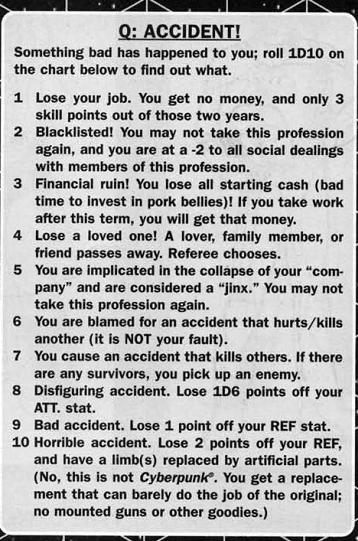
After looking at that chart, tell me, which is the smarter option?
Next time: I actually go over resolution mechanics in more detail, buy equipment, and more art!
Just take a Rookie Template next time, and a bit about Resolution Mechanics
Original SA post Mekton Zeta Part the Fourth: Encumbrance, Equipment, or just take a Rookie Template next time, and a bit about Resolution MechanicsOkay, so we're still in the middle of character creation for Hypothetical, but we're almost done with that part . Now it has come time to spend our Spacefun Bucks on gear our character won't actually be able to carry because of encumbrance rules.
As mentioned in my previous post in this series, Hypothetical can carry up to 3 kilograms of gear before being unable to move, while an average character can carry up to 23 kilograms of gear being unable to move. So, for those of you who don't use metric, Hypothetical is winded by picking up your average kitten, and an average person in Mekton Zeta can't lift and carry more than 50 lbs while staggering around at a blistering pace of... .22 miles per hour or about seven and a half times the speed of your average garden snail. So, the encumbrance rules for this game are clearly broken, in a bad way. Your average WWII rifleman carried around 82 pounds of gear and was certainly not considered much more than physically average, hell, hikers will commonly carry up to fifty pounds of gear and certainly get better than the 2 miles a day that this implies. I myself, as a child , hiked in the mountains with a forty pound kit and certainly made more progress than that and I was considered below average for my age. Of course, an average unencumbered man in Mekton Zeta also manages to walk a mere 1.3 miles an hour which is actually around half the average human walking speed, and run twice that.
So, leaving claims of unreality and possibly poorly thought out movement and encumbrance mechanics aside, let's get down to spending them Spacefun Bucks! Our fairly Wealth Hypothetical has 969 'credits' to spend on things, but first our GM has to decide what Tech Level the game takes place at. Tech Levels (TL) range from 1 (Sticks and Rocks) to 10 (super crazy advanced stuff), the equipment in this book actually ranges from 1-10, but below 3 and above 7 there is very little equipment actually listed. Now, while the game clearly assumes that Mechs are built at a TL above 5 (which is equivalent to modern day), there are actually no TL notes in the entire Mecha Construction chapter, which we'll get to in a future update. I've decided that Hypothetical lives in TL8.
Now, you would think that a guy like Hypothetical, rich, physically slow and weak, would have his own ride... but flipping over to the extremely limited section on personal vehicles (to be fair, the book states that these are purposefully generic) we find that the cheapest vehicle costs 1000 Spacefun bucks and there are no rules for used vehicles, so no civilian ride for Hypothetical. Now, if he had taken a rookie template, he would have either had enough money to purchase a vehicle outright, or some of them actually come with vehicles . So our Hypothetical has traded some extra skill points in exchange for having to buy everything himself and not having enough money to afford a motorcycle, let alone a car.
So, let's buy him a gun and maybe some body armor or clothes. Maybe he'll be able to 'commandeer' a car later. Now, weapons have a number of different features in Mekton Zeta, first, they have Weapon Accuracy (WA) which is a number either added or subtracted from you attack roll, which I'll get into later, then there's Range (which is the no penalty range), Maximum Range (-4 to hit), Damage (either a number of dice of Hits or a flat number of Kills for antiMek weapons), Shots (self explanatory), Burst Value (BV) the number of shots you can fire in one action, and Concealability, which is handled simply. Either a weapon is concealable in your pocket, in your jacket, in a long coat, or there's no way you can hide it. Weapons of course also have prices, weights, and minimum TLs.
Going over the weapons list, we need to find Hypothetical a weapon he can A)Use, and B)Carry. We decide on a 'Hideout Pistol' and note it does 1d10 damage, is good from 10-50 meters, holds 7 shots, fits in our pocket, and masses .75 kilograms (no notice if this is full or empty weight). We mark off 96 Spacefun Bucks and note that reloads cost 5. Now, most handguns actually do multiple d6s for damage, as I've mentioned before, so this makes it a bit odd. The description text also describes this as a 'lady's gun' but then says it is also used by everyone.
Now, there are are about nineteen other guns in the book, all deliberately set up as generic as possible, include double barreled and automatic shotguns, energy weapons, and machine guns. Energy weapons come in two varieties, variable damage dice and static damage dice. The variable damage dice weapons let you chose a range of damage (starting at one and going up to six dice for the rifle) and instead of shots the power pack holds a number of dice of damage. Both the variable energy weapons in the book hold ten shots at maximum power, while the static 'heavy' energy weapons both hold five shots and do slightly more damage dice. I would have bought Hypothetical an energy weapon, but they're all more expensive than he can afford, and the game has no rules for scaling money or prices at TL.
There are also 19 weapons in the book, ranging from spears to laser swords. I buy an Energy Sword for Hypothetical as well, even though he doesn't know how to use it. It has a range of 2 meters, does 5d6 damage, has 10 'shots', weighs .25 kg and gives him a +1 to hit. I mark off half of his cash because it costs 470, and note that Energy Swords don't take their wielder's strength into account, so maybe I should have bought Blade skill for Hypothetical. Wait a second, I have Knife +1 listed on here, but the game uses a generic Blades skill.... Somebody shoot the editor with their laser pistol at 1d6, please. So yes, he can use the Energy Sword. Checking the description, it says it can cut through parrying weapons if I roll double the maximum damage for the parrying weapon, and that it takes an hour to recharge in a wall socket after I've used it for ten rounds. The Energy Sword also fits inside a jacket... which I'm guessing means it's about the size of your average [redacted to avoid being sued by George Lucas].
Properly armed for his personal combat skillset, Hypothetical moves on to armor. Armor is complicated in Mekton Zeta, you buy it by hit location and material, now, there's no listing for TL below 5 in the armor section, except for shields and flight jackets. What that means is that apparently boiled leather, steel plate, and chainmail offer no protection whatsoever according to the writers, I guess? Why even include TLs below 5 if you're not going to be thorough about it. Even Alternity , for all its faults had Low-PL armors as well as weapons.
Anyway, getting back to buying armor. If we could afford it (we can't, no starting character can) we could buy a personal force screen, a heavy device that provides a variable amount of protection from up to 10 attacks per round, unlike standard armor, which is basically ablative protection. Or, if we had had a little more starting cash, we could have bought powered armor, transforming Hypothetical from a weakling into an average human as well as other bonuses. Sadly, we don't have access to either of those because of limited funding, so we settle on a standard space suit which provides 5 SP to all locations and a light ballistic vest for an additional 10 SP to his Torso, total costing 298 Spacefun Bucks. He adds another 1.8kg to his encumbrance and pretty much can't carry much of anything else because he's at 2.8kg in gear. If he reaches 4kg he won't be able to move!
So now Hypothetical has 105 Spacefun bucks left, and clothing and gadgets to buy and a very strict weight allowance to consider. We'll buy him a Uniform for half of our remaining cash and move on to gadgets after talking about clothes for a second. Clothes in Mekton Zeta consists of a few different options and a mention that each one is a full outfit, which leaves me to wonder what kind of outfit comes with the 'cloak' or 'long coat' options.
Gadgets is full of little useful things. It has notes for differences on items at advancing TLs, so your bug or video recorder actually does get better as technology advances. Now, we would but a tool kit to use with our repair skills, but we can't afford it (costs 100) and is too heavy (1kg). Other than tools, most of gadgets is camping equipment of various sorts.
Now we move on to Drugs & Medicines (aka Drugs). The opener mentions that this is not to be considered all-inclusive, and like most SF games, it focuses on unrealistic future 'super drugs' like regeneration sprays and broad spectrum poison neutralizers. Of note are Intelligence and Speed Boosters, which are the worst buffing drugs you can think of. They provide a +5 bonus (good) for 1d6+4 turns (bad) and if you use them more than once a week, it permanently reduces the effected attributed by 1 (really bad). Also of note is the TL10 drug that instantly heals you to full and even raises the dead, somehow.
Now we're done with the equipment section, and character generation.
So let's talk about simple conflict resolution (we're not getting specifically into combat yet, I have three pages of charts to dissect for that). Uncontested conflict resolution involves rolling a d10, then adding the appropriate attribute, and the appropriate skill. The game refers to your targets are Difficulty Levels, and they range from 10 (easy) to 30 (nearly impossible). Then of course it messes the whole curve up with Critical Failures and Successes. A critical failure involves rolling a one on the D10, then rolling again and subtracting that result from the total, you can't double fail, fortunately, as you only roll once no matter what you get on the second roll. Now, if you roll a 10 on your initial roll, you get to roll again and add the result, if you get another 10, roll again. I've seen that go on enough that players get 50+ on a die roll (which is only useful in combat, more on that later). The problem with this is that bad die rolls can wipe out any chance of success whatsoever for average character, but merely inconvenience more skilled characters. Also, and this is seriously game design 101, any die mechanic that specifically affects both PCs and NPCs will affect PCs more simply because PCs make more die rolls, I'll be getting into this more in combat, and I might even dredge up some examples from actual Mekton Zeta PBP I've run on the forums in the past.
Sorry for the lack of art, I will rectify that later.
Next time, we start Mecha Generation. Yes, START, there's a whole other book involved too, but we'll just cover as much of the basics as I can stand in one sitting.
You need Mekton Zeta Plus to Build Go-Lion (Voltron), But You Can Still Build Robot Lions!
Original SA post Mekton Zeta Part Five: You need Mekton Zeta Plus to Build Go-Lion (Voltron), But You Can Still Build Robot Lions!So here we have the thing that originally attracted me to the game in the first place, way back in the day. The Mecha Creation rules. Now, the chapter gets off to a bad start by basically telling us that the only balance these rules have is your own sanity or GM fiat. At this point I should mention that the PDF available through DRPG is terrible for copy and pasting, even though the security settings allow it, good luck actually getting any coherent text of it, as they didn't really redo the layout or anything to make it more accessible (as in the visual impaired sense, the rules, though somewhat nonsensical. are at least spelled out clearly in the areas where they are placed).
Anyway, the first section is Concept, according to the handy list on the sidebar here on page 52. Now, because I'm a glutton for punishment, I will be doing two designs here. One for Hypothetical, and one for the enemies that he would fight. These are the basic rules, so I won't be building any combing robots or Ideon or anything, but I will build a transforming robot.
Hypothetical will be piloting a transforming robot inspired by the Union Flag, as seem below.
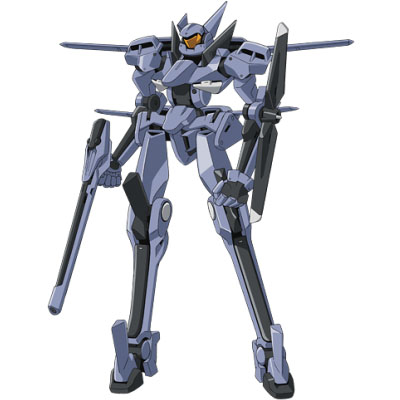
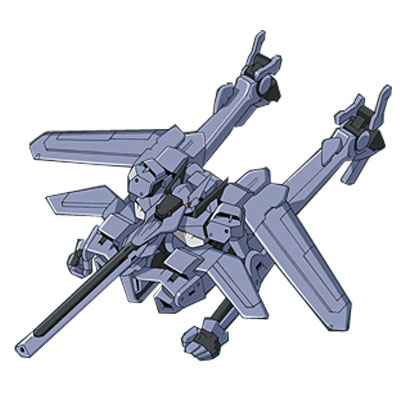
While the main enemy mech will be inspired by this because why the hell not.
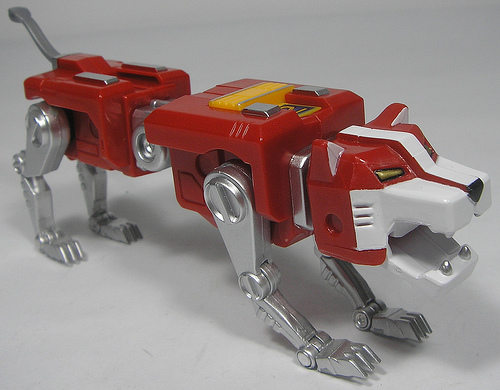
Now that we have out concepts firm in hand, we decide on body forms. Now, our Flag
 is a Mekton in its base form, which has no inherent advantages or disadvantages, we decide it has two arms, two legs, a torso, a head, and two wings for its servos. It will also transform into a Mechafighter, doubling its MA (movement, really good) but suffering a -2 to MV (not explained yet, bad).
is a Mekton in its base form, which has no inherent advantages or disadvantages, we decide it has two arms, two legs, a torso, a head, and two wings for its servos. It will also transform into a Mechafighter, doubling its MA (movement, really good) but suffering a -2 to MV (not explained yet, bad).
The enemy mech is clearly a Mechabeast, and gains +2 Kills to Melee damage a +2 to their Land MA (movement) and -1 MV (still not explained yet), it also cannot use hand held weapons (it's a fucking robot lion) and has four legs, a head, a torso, and a tail for its servos.
We could also make a tank, but why the hell would I do that (they're basically a torso and maybe a head for a turret).
Also on this page is a useful sidebar explaining how to determine the ratio of points for the good guys/bad guys based on the kind of mecha the series has. Basically, in a standard military series (like 08th MS team), the PCs have as many points for their mechs as NPCs on their side, but as the scale of the mechs involved gets higher, like one of a kind prototypes, the number of points the PCs should have versus the NPCs gets totally ridiculous (the book cites Shogun Warriors for that, a more modern example would be Gundam 00, TTGL, or Evangelion). It also mentions that in the large scale conflict of the setting, whichever side has more mechs should have less points to spend on each individually (unless you're feeling truly cruel) < their words not mine on the parenthetical.
Now, this is going to be a basic military game, so the knockoff Flag is going to be a basic mass produced unit, not a special prototype. Likewise the Red Lion will be a standard unit for the enemy forces. Since the enemy will have many more Lions than the good guys have Flags, we'll build the Flag on twice as many points.
What kind of points you might ask? Well Construction Points (CP) of course! These are an abstract measure of design work, materials costs, and construction difficulty of each unit, and so is worth however much the GM wants them to be. The game then tells us that the scale on CP ranges from 10 (cannon fodder, practically worthless) to 400+ (crazy super units) and breaks it down in a scale further to distinguish between basic stuff and officer models, advanced prototypes, super robots, etc.
Now, one thing I will mention at this point is that the rules of Mekton Zeta are more inspired by Macross and Gundam than they are anything else in anime. People familiar with both of those will understand a few points in the rules better as I go into more detail.
Before I actually give myself a CP budget, I'm going to go over the other things it mentions before we actually get into the meat of mecha construction.
Giant robots in Mekton use Kills (equal to 25 hits) to measure several things. Basically Kills are your hit points, run out and you explode, or drift uselessly in a hulk as you scream in rage, whatever. Your servos provide your base Kills... and that's it, there's no way to increase your Kills except by building a bigger mech. You can add Kills of armor, but they aren't extra hit points, they just reduce damage.
The next thing you need to worry about it Spaces, each servo has a set number of Spaces it holds, but you can trade off Kills for extra Space, at the rate of One Kill for Two Spaces, why you can't do the reverse is not specified or even mentioned. Basically, you put stuff in Spaces, be it weapons or thrusters or sensors or whatever. Spaces and Construction Points are the two big roadblocks in Mekton Zeta construction rules, while Kills and weight (next paragraph) are important, if you've run out of Space or CP, you're done or have to redesign to fit within the parameter you've run out of.
Finally we get to Weight. Weight is important because it determines how much it costs to fly a machine, and how well it maneuvers. Fortunately for us, Mekton Zeta makes weight calculation easy, 2 Kills = One (metric) ton. So whenever we need to find out our weight, we add up all our kills and divide by two, easy! Stuff will have listed weights, but fortunately whoever designed the mecha construction rules remembered this rule, and it is surprisingly never violated.
So, consulting the rule book, it suggests 10-100 CP for a basic 'Grunt' suit. So let's pick a nice round number for the Flag of 100 (we'll need it to fly in Mekton mode, flight is expensive ) and that gives us 50 CP for the Lion.
Now we go to the first section with charts and stuff (so many charts) Servos . We start by picking our Torso from the 11 choices we have. Torso choice is especially important, because for units expected to operate under gravity, attached servos must be no smaller than one size smaller and in any case can be no larger than one size bigger than our torso. The torso is where most our Kills will be located, holds the powerplant, can hold the cockpit, and is the linchpin of your mecha, so we want it to be as big and as armored as fits within our concept/we can afford.
We have 100CP for our Flag, but remember, the heavier it is, the harder it is to fly, so we settle for all Striker parts (torso, 2 arms, two legs, 2 wings, a head), this costs us 31 CP.
Now, for our Lion, the choice is simple, we have 50CP to spend, these things aren't going to fly or do anything fancy (I'll put a beam weapon in the head and claws on the feet, but that's about it) so we're going to make them big and tough. We chose a a Medium Striker Torso, Striker Legs, a Striker Head, and a Light Weight tail. This costs us 29 of our CP already, I might have to skimp on armor for them...
Now, since both of our designs have arms and/or legs, we need to decide on extremities for them. For legs, feet are free and cost nothing. Hands, however, and built-in weapons, cost. The Flag gets 2 Hands, costing another 4CP, while the Lion gets 4 Talons, costing 8CP and reducing our MA by 2, this exactly eliminates our bonus from being a Mechabeast, but now our claws do 7K damage, enough to cut right through our Flag if we do something stupid like not armor it.
One thing I haven't touched yet is that there is another Servo type, the Pod. The pod is basically a hollow part that weighs only as much as the stuff you cram into it, and the armor shell you put on it (unlike other servos, armor is required on Pods). I won't be using Pods because you can really cram stuff into them, and while that is totally munchkin, it won't be required to show how broken the combat rules are, because I already have examples.
Now we need to buy armor. You can armor a servo up as much or as little as you want, keeping in mind weight, cost, and the fact that you can't armor more than two levels over the size of the servo. Now, since both of our units are fast moving grunt suits, we want lighter armor for them, as you buy armor for each part separately, that gives us the advantage of armoring the torso more than the rest of the unit. For the Flag we go with Light Weight Armor for the limbs, wings, and head, and take Striker armor for the Torso, this costs us 15CP, totally our CP to 50, or exactly half our allowance. For the Lion we go Superlight for the legs and head, no armor for the primarily decorative tail, and Light Weight for the torso, costing us 7CP, and putting our total at 44CP.
Anyway now that we have our frame designed out, we want our Frame Weight, which is used for certain calculations, like estimating how much CP I will have to blow on flight. The Flag totals 33 Kills of structure and 13 Kills of armor, or 46 Kills total and a Frame Weight of 23 tonnes. The Lion totals 41 Kills of structure and 7 Kills of armor, or 48 Kills total and a Frame Weight of 24 tonnes. The Lion has a slight weight advantage, but not enough to provide any modifiers in combat.
Next we move on to Subassemblies, which is basically everything else that takes up space that isn't a movement system. Since this is the basic ruleset, there aren't a lot of options here (to be honest there weren't a lot of options in the earlier section either, everything moves in set increments of either 1 or 2) and so we pick Basic Sensors for both, costing 4CP, we put them in the Head Servo for both, taking up 1 Space and 2 Kills.
Then we move on to Cockpits, again, we only have a few options here. It mentions that if you have someone sit in your lap you take a -1 to all rolls, and gives the option to buy additional seats for passengers. Since neither of these are trainer models, we'll skip that. Then we get to the different types of cockpit, of which there are two in the basic rules Open (think fighter jet) and Closed (tank). We select Closed cockpits for both designs. Cockpits don't cost anything but do take up space, we put them in the Torso for both designs.
I should mention that there are sections here for reskinning the purposefully generic things (armor, cockpits, sensors, etc) to more specific things that fit in your campaign, which is one of the few nice touches (although the advanced rules for cockpits in Plus kind of throw that out the window). So if you wanted to stand in your cockpit and throw punches at the enemy or telepathically control your robot that's technically supported by the basic rules, although it has no mechanical effect.
Now we get to weapons! For the Flag we're going to give it a handheld rifle, a shield, and a melee weapon stored in one of the arms. Although our inspiration doesn't have one, we're taking a beam weapon as our handheld rifle. Handheld weapons in the basic rules don't take up spaces, but they can't be bigger than the servo that will use them. So we pick a Medium Beam Gun (which takes up 4 spaces and costs 5CP), a Sword (which also takes up 4 spaces and costs 4 CP) and mount a Small Shield (which takes up 1 space and costs 7.5CP), For the Lion we look over our dwindling CP reserve and realize the only thing we can buy is a Small Beam Gun, which costs our last 2 CP and we fit it into the Head.
We could have also bought projectile weapons, missiles, or even drills
 but we're trying to conserve CP, Space, and Weight here, and our concepts didn't call for those.
but we're trying to conserve CP, Space, and Weight here, and our concepts didn't call for those.
Now we get to options, most of these don't weigh anything or take up space. We buy an Ejection Seat (1CP) Liftwire (.3CP) and a Stereo System (.2CP) for survivability, the ability to get into the cockpit without jumping, and the ability to blast Kenny Loggins in our cockpit, respectively, for our Flag. The aliens apparently don't believe in luxuries like ejection seats, so the Lion gets nothing.
Total CP so far: Flag 72CP, Lion 50CP
If we wanted to, we could put wheels or treads on our mechs at this point, but I don't feel the Flag needs them in Mekton form, and I can't afford anything for the Lion.
Final Weight is the next step, important because we need it to figure out how much Flight CP I need to buy to make the Flag actually move in the air. Anyway, while all the charts I have referenced (but not displayed) so far, have had weight values on them, we literally throw all those numbers out and just add up our Kills and divide by two . Again, easy, but then why bother to list weights for things (which are usually half Kills anyway?)
So we take the 46 and 48 Kills respectively of each mech, and add on the kills of subassemblies, which clock in at 16 for the Flag and 3 for the Lion. Now the Flag is the heavier of the two mechs at 31 tonnes with the Lion clocking in at 25.5 tonnes. Again, this much difference usually isn't enough to care about.
For the Lion we're actually mostly done, just a few more things. But for the Flag, we're just beginning.
Now that we know how much the Flag weighs, we need to make it fly. Now, we get a +2 Flight MA bonus to the Flag for having proper sized wings (two sizes smaller than the torso or greater) and so in order to obtain true flight we only need to aim for an achievable MA of 6 (minimum flight MA is 8, lower values are possible, but represent jump jets and not true flight.) Consulting the Lift Point table, I see I need to multiply the weight of the Flag by 0.225 to determine CP and Spaces to allocate to thrusters to enable flight. Resulting in a 7 (actually 6.975, but I'm rounding up). We have to allocate 7 Spaces of thrust and pay 7CP, which increases our total CP for the Flag to 79. I put 2 Spaces of thrust in each Leg and the remaining 3 Spaces in the Torso. Now, I could have arranged them differently, but this makes the most sense. I also could have used the optional Fuel rules (add 10% to weight) but the original Flag is solar powered and uses an electric scramjet for flight, so it doesn't actually use fuel.
We also discover that a Flight MA of 8 gives us a top speed of about 90 mph. Not too impressive, but this isn't a supersonic robot, it's a combat mode for a transforming jet fighter. Speaking of transformation, this is where we cost that out. Now, transformation in Mekton Zeta is represented by having, sigh, multiple sheets for each mecha. So we need to go back to step one and rebuild the Flag from scratch as a Mechafighter.
But before we do that, we need to add the cost of transformation to the Flag, which is Cost Multiplier. Basically, different types of transformation add a percentage of your mech's cost to your total. For a Mechafighter, we add 30%. So 79*1.3=102.7... damnit, we're slightly over budget. But never fear, there's a fix for that just ahead!
The final cost multiplier is Powerplants, which come in two varieties: Cold, safe but normal cost, and Hot, explosive but cheaper. We make the Flag's powerplant run Hot (just because our inspiration was Solar Powered doesn't mean we are!) and save 10% on our costs, taking us down to 95CP (94.8, but rounding). We leave well enough alone at this point.
Now, instead of going back and redoing the entire process for the Flag's fighter form, I'm going to literally just move the beam rifle to attached instead of handheld to the torso, and call it done, it behaves exactly the same except having a -2 to MV and double flight MA (so 16).
Finally we get to find out what MV is! MV is your Maneuver Value, a number that is subtracted from your Reflexes to get your Mecha Reflexes, that determines the stat you roll in combat. Now, the Flag is just over the threshold on the MV chart, so it has a -3 in Mekton Form, and a punishing -5 in Fighter Form. The advanced rules in Mekton Zeta Plus let us play with MV, but the Basic rules are straight dependent on weight. The Lion actually has a slight advantage, as it fell on the -2 side of the chart, but being a Mechabeast it ruins that and ends up -3 MV anyway. We also find out our Ground MA here, for both of them it is 5, because the Ground MA chart doesn't have as many steps as the MV chart.
And that's it, we're done with (basic) Mecha Creation!
There's some extra stuff in the basic rules but I'll cover that next time. I've been working on this for what feels like hours (and probably was).
We Put your Mekton on a Mekton, so you can Mekton while You Mekton
Original SA post Mekton Zeta Part 6: We Put your Mekton on a Mekton, so you can Mekton while You MektonLet's start with a quick art update, most of these images are from the character creation chapter.
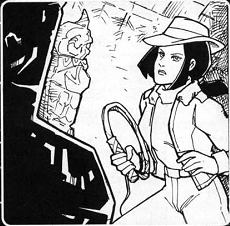
From the section on Professionals. However, I don't think they actually listed archaeologist as an allowed profession... *checks book* oh, it's listed under Explorer (D). Never mind that the game doesn't really support that kind of play.
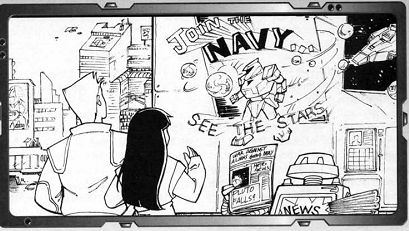
Fairly self explanatory.
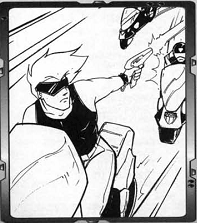
From the section on skills, or as I like to call it 'Hypothetical's Misspent Youth'. There's actually a bunch of these, what follows are the ones that struck me as particularly bad/amusing.
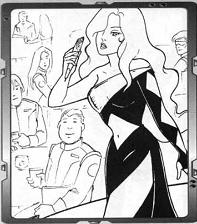
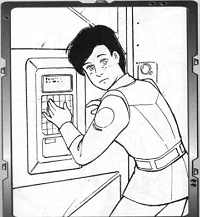

I just don't know man. I just don't know. This is from the equipment section. Where does his sword go? Or, assuming he has an energy sword, why does it have a crossguard?
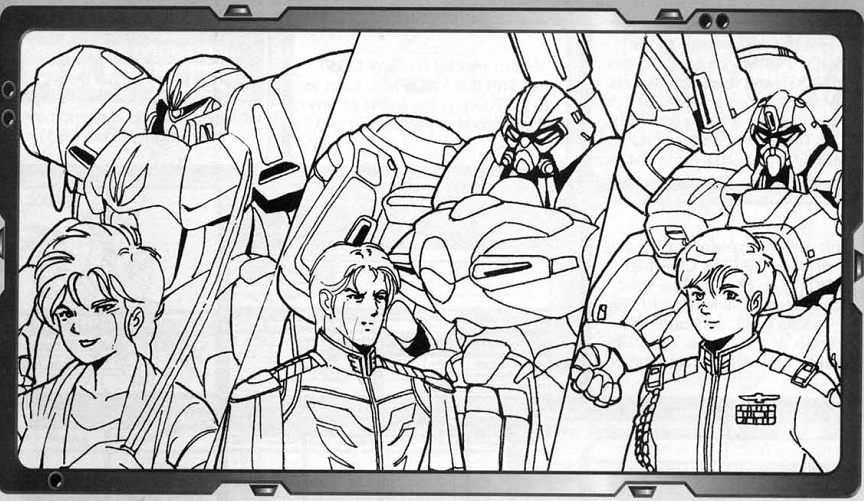
One of the few pieces of art in the mecha creation chapter. This is more of the knockoff gundam and macross stuff from Invasion Terra.
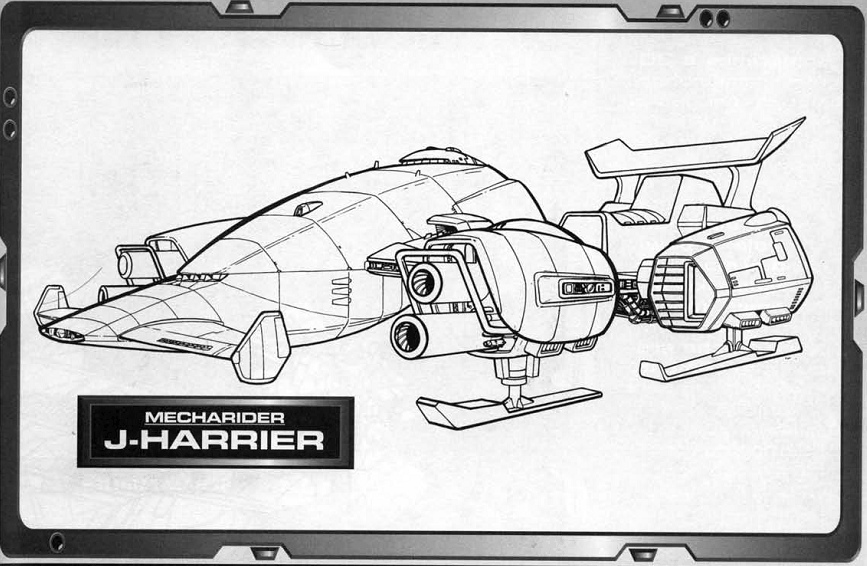
And now to the actual point of this update, Mechariders, Roadstrikers, and Starships.
Mechariders are basically Mekton that you designate as being rideable. While there are rules for how they work, there is little explanation to how they work. Mecharider's do take an additional -2 MV, but given their weight rules, that means you'll usually have a -3 instead of a -1. So if you wanted to, you could have one PC ride another into battle. Aside from being able to carry five times its weight (somehow) and being controlled by the Mekton that rides it, the rules for these are pretty sparse. In fact, it takes up about half a page (the rest of the page is taken up by the picture above), so let's go ahead and quick roll out a Mecharider for our Hypothetical.
We buy a Torso servo first, and since it has to be able to support our Flag's 31 tonne weight, we go with a Medium Weight torso (12CP, 12 Spaces, 12 Kills, 6 tonnes), slap Medium Striker armor on it (5CP, 5 Stopping Power, 2.5 tonnes), skip sensors and cockpit since this is essentially a giant motorcycle, throw in two Rocket Pods (-1 WA, 2K damage, 3 Kills, 20 Shots, 4 Spaces each, 4CP) and Heavy Striker Wheels (5CP, one 3 Kill wheel and one 2 Kill wheel, both obviously in the torso).
As long as we're here, I'll cover wheels, treads, and rocket/missile rules. Rockets and Missiles are handled differently than other ranges weapons, instead of having a Rate of Fire, the pilot can fire as few as one or as many as all of his missiles in a single location at once. This provides bonuses, as we'll see in the next update, when I cover the insanity that is Mekton Combat.
Wheels add a flat +2 Ground MA, so why are there different sizes? Well, because you lose that MA if the wheels are disabled, so bigger/heavier wheels take more damage before being disabled or destroyed. Like legs, you can't have wheels smaller than one size category smaller than your torso, or two larger. In addition, you have the option of splitting your wheels up between different servos (with a minimum of one Kill per wheel). Wheels take up no spaces, so there's no real penalty to having as many wheels as you have Kills (in fact, that's a pretty good idea). You can't armor them, but they share the armor rating of the servo they're attached to. All wheels must touch the ground to get the MA bonus. Treads use the same rules for damage as wheels but they don't provide an MA bonus, just remove the MA penalties for rough terrain. You can buy both, somehow.
Anyway, back to our Mecharider, the Hypo-cycle
 . Adding up its total Kills we get 28, so it weighs 14 tonnes, giving it the best Ground MA and MV values 8MA with wheels and -3 respectively. It can carry 70 tonnes into combat, so it could technically haul two Flags into battle, and has rocket pods for an offensive punch. Now, why you actually use this instead of the Mechafighter mode, I have no idea, although if you needed the missiles it might be a good idea.
. Adding up its total Kills we get 28, so it weighs 14 tonnes, giving it the best Ground MA and MV values 8MA with wheels and -3 respectively. It can carry 70 tonnes into combat, so it could technically haul two Flags into battle, and has rocket pods for an offensive punch. Now, why you actually use this instead of the Mechafighter mode, I have no idea, although if you needed the missiles it might be a good idea.
Mechariders get more ridiculous in Mekton Zeta Plus, for one reason you can remove MV penalties in Plus. Since Mechariders tend to be smaller and cost fewer points than their Mekton cousins, you can make truly ridiculous Mechariders with the rules in Plus (despite Plus kind of forgetting they even exist).
We're still not done with the mecha creation chapter though, because we have Starships and Roadstrikers to cover.
Starships are big, they start at 200 Kills and move up to 2200 Kills, they don't, however, get a larger number of Spaces. Instead, they use scaled up parts (Mekton Zeta Plus makes designing spaceships a little simpler, but the same basic rules apply). Now, since the game is kind of a dick about telling the GM they're supposed to design all the spaceships in the setting, I will design another two things for your possible enjoyment. The Intrepid (Hypothetical's carrier) and the Vengeance (bad guy super-carrier).
To start, the Intrepid will be a light strike carrier, carrying maybe a few dozen Mekton in battle, we're going to pick a Light Heavy hull for the ship, for reasons that will become apparent in a moment. As for the Vengeance , it's a Super Carrier, capable of carrying other starships with it (as cargo), so we pick the Mega Heavy hull for it.
Unlike in the creation of lesser machines, weight is meaningless to starships, you just pick a number that sounds good from the range listed for each hull type. The Intrepid , being a Light Heavy ship, has 1400 Kills, 14 Spaces, a base cost of 7000CP, and weighs between 350,000 tonnes and 999,999 tonnes, we pick a number in between and decide that the Intrepid weighs 600,000 tonnes. For the Vengeance , as Mega Heavy, it has a ridiculous 2200 Kills, 22 Spaces, costs 11000 CP, and weighs however much we want it to as long as it's at least 2,200,000 tonnes, so we decide it weighs three million tonnes, because why not?
We then note that they're both lumbering beasts, Intrepid adds seven hexes of movement to all turns, and Vengeance adds eleven . That done, we move on to armor, since weight is no longer a concern, only cost (and even, cost is entirely up to an arbitrary GM 'budget' since players aren't expected to design spaceships) matters for armor. We can put any level of armor on any level of hull. So, since I don't care about points and these are both major ships in the setting, I put Mega Heavy armor on both. This provides 110 points of Stopping Power (they're effectively immune to Mekton-scale weapons in the basic rules without rolling a crit) and costs 5,500CP.
Then we move on to weapons. Weapons have firing arcs, fairly self explanatory there, forward, aft, sides, fixed, all, etc., and also come in either ship-to-ship or anti-Mekton (CIDS), CIDS ignore the penalty for hitting Mekton-sized targets as a ship. Now, as for the Intrepid , we're outfitting it with two weapons. A Core Cannon (fixed forward arc, 250 range 1000K damage, 1000 Kills, 10 Spaces, 12125CP) and a Deluxe CIDS (all arc, 13 range, 10K damage, infinite burst , 1 Space, 172CP). For the Vengeance we're giving it two Superheavy Batteries (one forward, one rear, 180 range, 500K damage, 500 Kills, 5 Spaces each, 6565CP each), and two basic CIDS (9 range, 5K damage, infinite burst, .5 Space each, 86CP each).
We don't take a Screen for either, but I'll explain how they work. Basically it's extra Kills. Screens stop attacks, but lose Stopping Power on a strictly ablative basis. When they go down from damage, they're out for the rest of the battle. They also prevent you from entering or leaving the ship while they're up, and they take a turn to raise. Unless your typical enemy ship severely outguns you, it's not worth it.
Now we move on to Subassemblies. We only have 3 Spaces left on the Intrepid , and guess what? We need two of those Spaces just to have a crew and an engine! So we spend 1 Space (and 1000CP) on Mecha Support Facilities, noting that we can repair, refuel, store, and launch 50 Mektons. We also spend another Space (and 500CP) on Passenger Facilities, allowing us to hold 490 people.
The Mega Heavy Vengeance has more Spaces, having spent the same number of Spaces on weapons, but having more to begin with. We still need two Spaces reserved for crew and engines, so that gives us 9 Spaces to use. We spend roughly half of those on Cargo (2000CP for 4 Spaces worth of Cargo) and discover that a Space spends different here depending on how big your ship is. So we get 24200 tonnes worth of cargo, or enough to carry a few superlight or light weight starships in its hold. We then spend five Spaces and 5000CP on Mecha Support Facilities, allowing the ship to field six hundred Mektons. At this point I'm imagining it looking something like this.
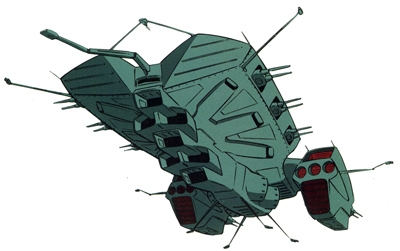
We then buy Passenger Facilities for the Vengeance and note it holds 1210 crew.
Now that we're done with Subassemblies (seriously, that's all the subassemblies, mecha bay, cargo, passengers, that's it). We need to add up the costs of everything because everything from here on out is a cost multiplier. The Intrepid costs 26297CP, and the Vengeance costs a whopping 37302CP, so far.
Now we get Engines, and use up that last allocated Space for each. We decide that the Intrepid is a fast attack carrier, and blow a shitload of points for Space MA 20 (x.5 multiplier) while the Vengeance is a slow lumbering beast with Space MA 8 (actually gets back x.1). The Intrepid lacks a Hyperdrive, but the Vengeance needs one, this adds the ship's entire cost as a multiplier, starships are literally twice as expensive as the equivalent spaceship. At TL8 the Vengeance manages 1 Light Year a week, not that fast, but still decent for getting around the stellar neighborhood, but a trip to another spiral arm is going to take years , even decades , so these guys have to be from somewhere relatively close by.
Now we buy Crew Quality. Instead of parceling out backgrounds and points to every single person on your ship, you get another cost multiplier which represents the average competency of the crew. The crew of the Intrepid is plucky and daring, but they're not elite. So we'll give them a C-Grade crew, rolling 12+1D10 and costing an additional x.2 (total CM .7). As we're already in crazy cost territory on the Vengeance , we give it an A-Grade crew, who roll 16+1d10 for ship rolls and again cost as much as the ship itself (total CM x1.9)
So, the Intrepid ends up costing 44704.9 CP, and the Vengeance clocks in at 108,175.8 CP . There are only two sidebars in this section, one of which is kind of important, and the other one is an AU chart. The important sidebar talks about how spaceships are supposed to work in game, basically, you've got your plot ships and your 'scenery'. Both of the ships I've just designed are plot, which means they don't have a powerplant critical hit location . Technically, both of these ships are invincible, as they can always run away from a fight before they're totally destroyed. Scenery ships are just there to take up space, be moving hazards to PCs, and get blown up in pretty explosions.
So why design or even give rules for ships at all? Because Mekton Zeta, that's why.
Roadstrikers!
Roadstrikers are a crazy hybrid between the human scale rules and the Mekton scale rules. They use 50 meter hexes (Mekton hexes) for a lot of things, but use human scale movement for walking movement and do Hits instead of Kills for damage.
Roadstrikers are also the first example of the Scaling Rules used in Plus, which I will go into detail when I cover Plus. As such, I'm skipping over most of the Roadstriker section, except to mention a few things.
First off, Roadstriker cockpits take up a number of spaces equal to the pilot's BOD stat, so the bigger the pilot you're designing it for, the fewer Spaces you have to use. You can divide up the spaces between different servos, and this is encouraged, Roadstrikers are more power armor than they are proper giant robots.
The real advantage of a Roadstriker over a Mekton is the possibility of concealment. Transformable Roadstrikers can disguise themselves as cars or motorcycles, as well normal jet fighters... Roadstrikers are basically Transformers with human pilots (although Plus lets you build AI driven creations...) In addition, Roadstrikers serve as an intermediate options for players and GMs who don't want to go into full scale Mekton combat.
I would build a Roadstriker for Hypothetical, but this post is already super long, and I don't feel like any more math after those spaceships.
Next time: The Crown Jewel of the Mekton Zeta Basic Rules Insanity: Combat!
Combat 1/3
Original SA post Mekton Zeta Part I didn't forget about this, it's just THAT PAINFUL: COMBAT! Part 1 of up to three.So, combat... where do I start. Well, I suppose we'll start at the beginning and run an example combat.
Our Hypothetical character from previous examples is out cruising in his Flag
 when he runs into a single Lion, also apparently out on patrol. Both parties roll Initiative: which is a d10 + their (Mecha) Reflex stat. Hypothetical rolls a 1 and adds his Mecha Reflex of 6 (he's not in Fighter mode), getting a 7. The Lion pilot, who is absolutely average, for some reason also rolls a 1 (blasted dicebot) and adds a 3 (Average Reflexes of 6 minus 3 for MV).
when he runs into a single Lion, also apparently out on patrol. Both parties roll Initiative: which is a d10 + their (Mecha) Reflex stat. Hypothetical rolls a 1 and adds his Mecha Reflex of 6 (he's not in Fighter mode), getting a 7. The Lion pilot, who is absolutely average, for some reason also rolls a 1 (blasted dicebot) and adds a 3 (Average Reflexes of 6 minus 3 for MV).
So Hypothetical goes first. Now, each character in a combat gets two Actions on their turn, which range from moving, reloading, or slashing claws against a dude's face twice (yes, you get to attack with claws twice, even if you only have one hand with claws).
I'm actually going to ignore making a gameboard and what not for this, because that is way more effort than I want to put into it. The game uses hexes and facing, similar to say, Battletech, but also has miniatures rules, similar to say, Heavy Gear. But, since this is Mekton Zeta, it isn't as good as either of those.
One interesting thing about the Mekton Zeta mini rules is that you can use them with toys or Gunpla or whatever, as long as your figures are relatively uniform in size and you don't mind having battles take up entire football fields (mild exaggeration, when using figures/models it says to make the hexes twice the height of the average figure, if you're replicating the OYW with HGUC, you'll probably want a regulation size basketball court for any particular battle).
Now if functioning at human scale, each hex is a meter, but we're in Mekton, so the scale is one hex = 50 meters instead. Now, what this means is that the Flag can move 400 meters in a single turn, but it can't really do anything else if it does that, so Hypothetical declines to close and instead decides to open fire with his Medium Beam Rifle.
Don't worry, I'll get back to movement when it's the Lion's turn. It's complicated.
Now, I've arbitrarily decided that the Lion was behind a hill and so only became visible 150 meters away from the Flag, which was flying low to avoid enemy radar. So we have a range of 3 hexes to target, which is well within range. He lines up and fires two shots, since these are beam weapons, the Lion can only Evade.
So let's roll some dice and add modifiers. Hypothetical rolls a d10 and adds (6 for Reflexes + 8 for Gunnery) and gets a 7 on his die roll, resulting in a 21. The Lion has to get a 21 to avoid the shot (guess what, that's impossible). I give the Lion a roll because the results still matter, he rolls a d10 and adds 3 for Reflexes and 3 for Mecha Piloting, getting a 13. Since Hypothetical hit, and hit by... more than 5, we get to go over the most broken part of the rules!
Now, if you beat your defender by 5 or more, you score a Critical Hit. This lets you roll on one of three different hit location charts. One is boring and just hits servos. The other two can seriously fuck over a character. The first is the Special hit chart, which damages things like sensor, weapons, the cockpit , etc. Now, there's no real reason to chose to roll on this chart (aside from a lucky cockpit hit that makes it through armor), because you can roll on the Cinematic chart instead.
We get a 6, ammo explosion. Too bad the Lion doesn't have ammo, and there's nothing in the rules that say to reroll, so the shot is actually completely wasted.
That's okay, we have another shot. The second shot results in a 19 versus 7... which succeeds by more than 10, so it Mega-Crits instead of Criticals. A Mega-Critical (unless called) is just a normal hit, except it ignores armor entirely. Now we get a 4 for our hit (which is Pod, or Torso if no pod). Since the Lion uses a Medium Striker Torso, it had 8 Kills, now it has 5. Another two hits like that and it's out.
But now it's the Lion's turn! Now normally we'd have to worry about facing and turning radius and stuff but this is the bare bones example section. Now, walking lets you move 1/2 your MA for free, and the Lion can easily get adjacent on that, so now it unleashes a stream of deadly talon attacks! It rolls 1, 8, 5, and 4, adding 6 to those each, for 7, 14, 11, and 10. Here's the problem. I don't even have to roll those because Hypothetical's Mecha Piloting (8) plus his Mecha Reflexes (6), means that all of those attacks miss.
So yes, I just broke the system in half unless I, as the imaginary GM of this situation, want to put our starting character up against enemies that are just as cheesed as he is.
Now that the example is over, I'll proceed to explain why, even against evenly matched targets, Mekton Zeta is broken. To begin with this is the combat 'cheat sheet' included in the book, it's three pages long.
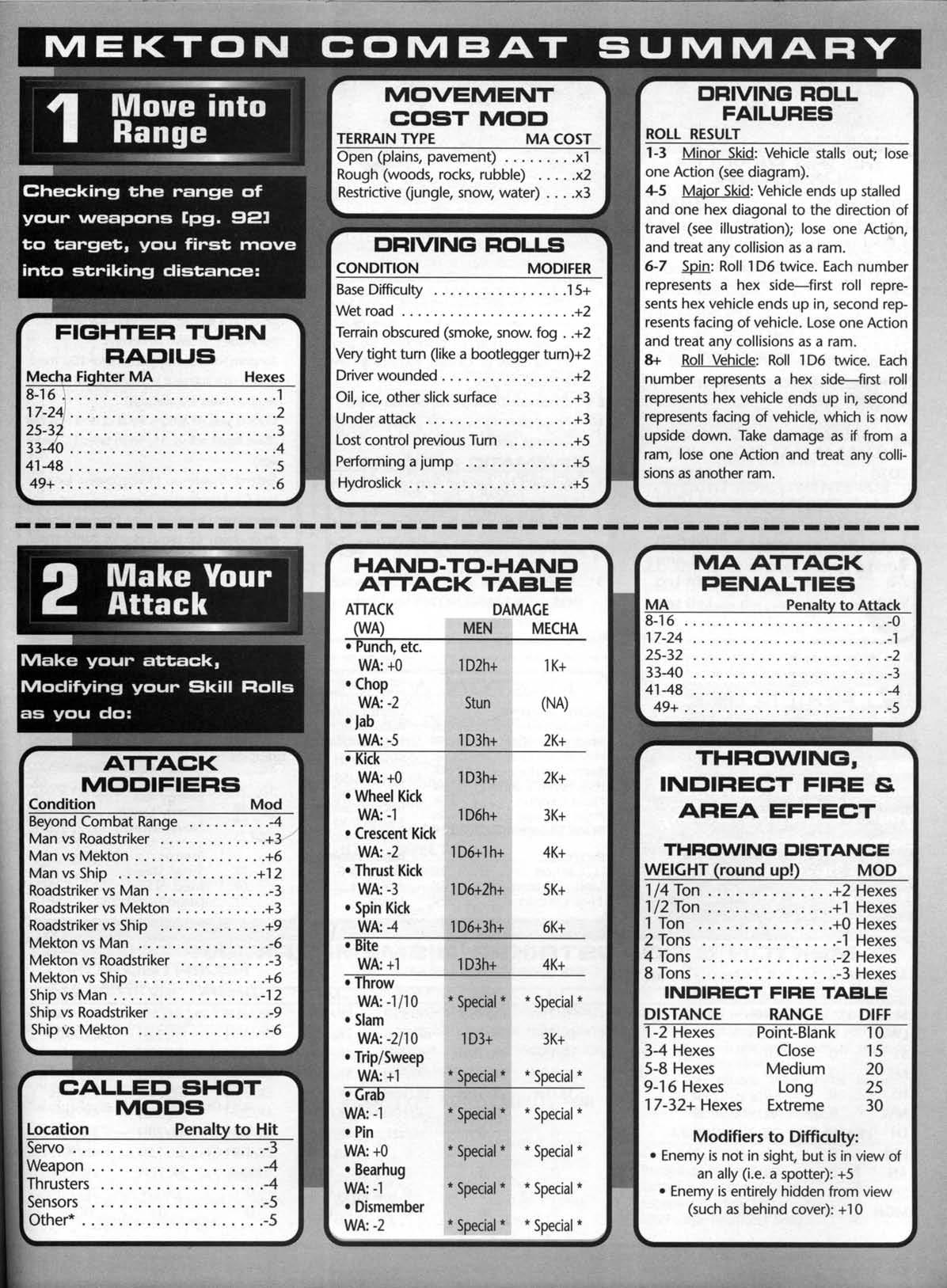
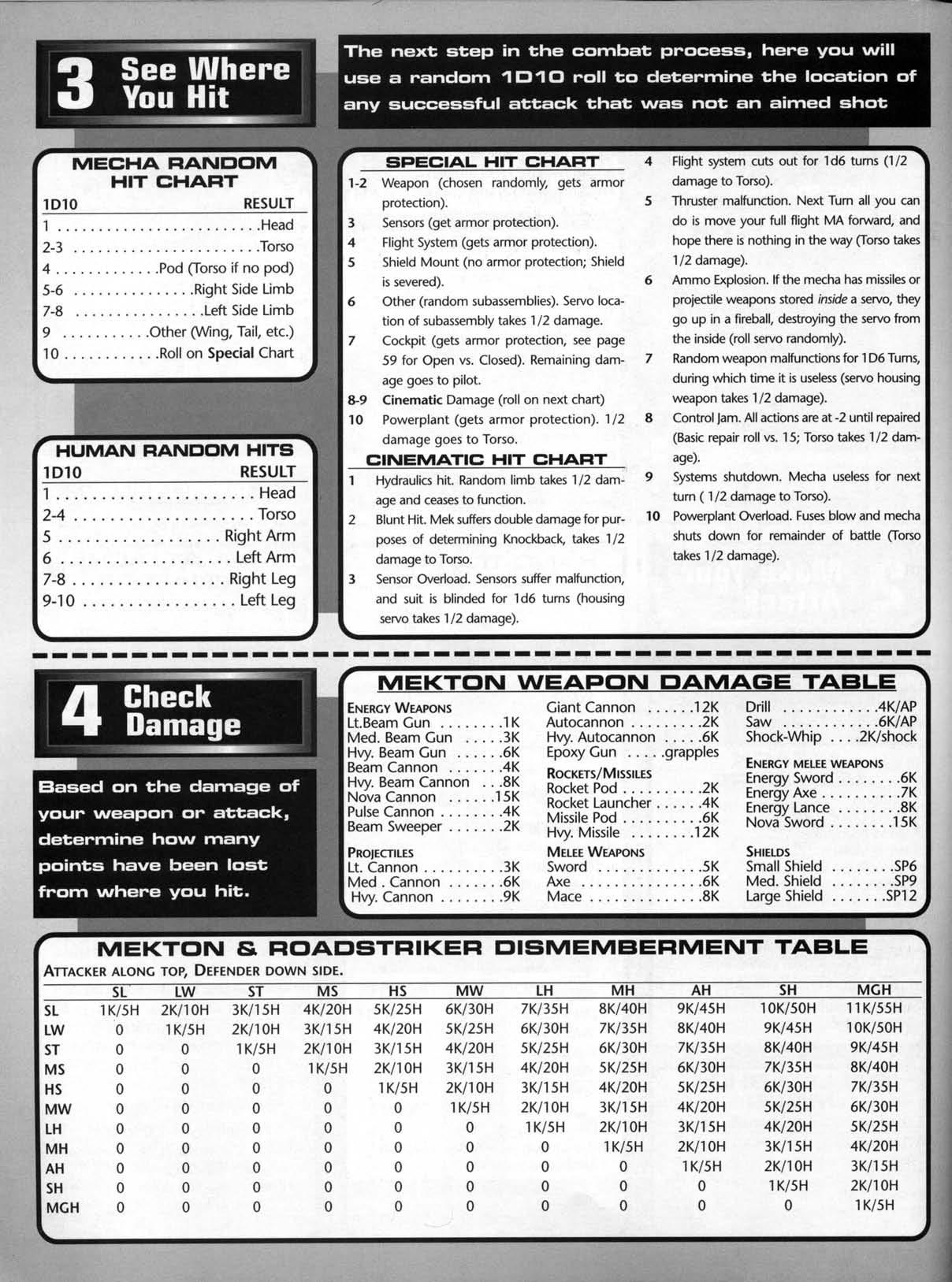
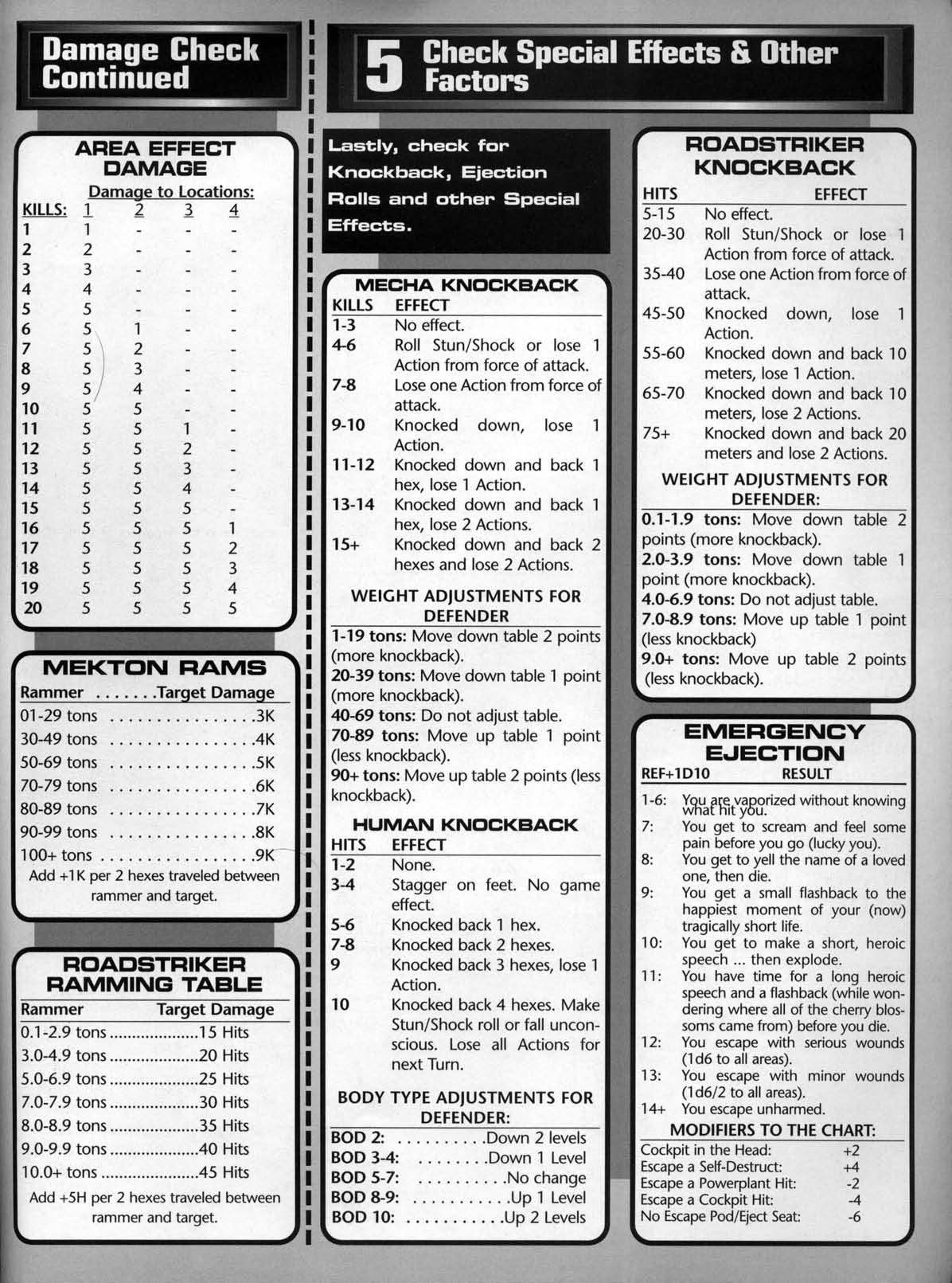
Even with those charts, you still need to consult the book for things like your WA modifiers, know what a Critical or Mega-Critical is, and understand how most of those charts even work . Basically, the writers were I guess not sure if they wanted write a wargame or an RPG and just threw both of them in a blender. For example, facing.
Facing determines whether you can attack or defend, and with what. For example, you can only Evade attacks coming from your direct Rear arc, and then at a -2. Now, thankfully, aside from knowing that you can only attack/parry in the front three arcs and Evade with a slight penalty in other arcs is one of the few bits of sanity we'll get out of Mekton's combat.
Movement involves changing facing, complete with each type of thing (Mekton, Beast, Tank, Fighter, Person) all having different rules on how they change facing. Fighters have to travel forward a set number of hexes based on how fast they can go, not how fast they're currently moving, how fast they can move.
We have walking, which doesn't take an action to half movement, and then does at full. Walking is the only movement mode that doesn't take one of your two actions in a turn (you can stay stationary in anything that can stay in one place on its own without an action, so no fighters hovering
 ). Every other movement mode is one action for 1/2 MA and 2 actions for full MA, with some kind of extra rule, like wheels only working on smooth terrain (unless it has treads too), and flying stuff having to accelerate. Also, the faster you fly the higher an attack penalty you have.
). Every other movement mode is one action for 1/2 MA and 2 actions for full MA, with some kind of extra rule, like wheels only working on smooth terrain (unless it has treads too), and flying stuff having to accelerate. Also, the faster you fly the higher an attack penalty you have.
There's also vertical movement, which is basically just an extra layer of hexes on top of the other hexes (the game recommends using a die to keep track of vertical hexes) and flying units and things with jump jets (flight MA below 8) can move either vertically or horizontally (although jump jets land at end of turn if they didn't otherwise).
Next on movement we have obstacles. Obstacles are basically things like buildings, hills, trees, swamp, etc that get in your way and possibly provide cover (next paragraph). Most significant obstacles you have to go around, although at human scale you can go through buildings. Less significant obstacles like stands of trees you can try and go through.
Then we have cover, which is basically up to the GM. If you hit a target who's behind cover, and you're rolling hit location, if you hit a covered location, you hit the cover instead.

We're back in the actual attack section now with things like called shots, burst shots, indirect fire, and other assorted craziness.
Now, speaking of called shots, it's -3 to hit a specific servo -4 to hit nearly everything else (not powerplants, that is a THING) and -5 for other stuff (I'm guessing cockpits would be -5). So, in our earlier example, it would have been more advantageous for Hypothetical to just try blowing the Lion's head off with every shot, not that he was ever in any danger.
Incompatible with called shots is burst fire. Burst fire is broken, for several reasons. First, if I had given Hypothetical a Burst Weapon in our earlier example, the Lion would have been broken in pieces after the first shot. Basically, for every one point you score higher than the defender, the defender gets hit again up to the weapon's Burst Value , and there are weapons with Burst Value: Infinite (basically always does another extra hit no matter how high you rolled). In addition, if you have a burst firing weapon, you may split up your attack amongst adjacent hexes, rolling once and then forcing everything occupying those hexes to defend and taking hits up to how many shots you allocated per hex (again, this is even more broken with Infinite, which is available for PC weapons in Plus).
Then we get missile/rocket salvos, which combine burst fire with even more complications and is actually more broken. Basically, a rocket launcher allows you to fire up to all of the stored rockets at once and the more rockets you fire, the more rockets hit the target per point they fail. If I had given our Flag three linked 20 missile pods, we could have buried the Lion in all 60 shots with that second firing, which would have left the Lion a smoking crater. For missiles/rockets you use the burst fire rules, but instead of one hit per point, it's X hits per point where X is the number of projectiles fired/10 (minimum 1). Then, once you've determined the initial hit location, you move up or down the table (attacker's choice but only one direction, not up then down to hit the same location twice unless you hit a LOT of missiles to loop around) for each set of missiles, instead of rolling them randomly.
Oh, by the way, there's nothing in the rules that says that burst/salvo fire can't Mega-Critical and that's where I'm stopping for today. Next time I'll cover indirect fire and robot kung fu...

Combat 2/3
Original SA postPurpleXVI posted:
Has anyone done Mekton Zeta yet? I've always been curious about that one. Some people leap to it as their first suggestion for mecha games, others will tell you it's a creaky pile of crunchy crap.
Yeah, I plan on finishing that one of these days. If I remember, I was just about to go into the insanity of the scatter rules, but I got distracted by... something, I don't remember what.
So Belatedly Presenting Mekton Zeta Part WTF: Combat 2!
Indirect Fire is the bane of sense in most mecha combat wargames I have been exposed to, usually looking something out of the early Renaissance or the Napoleonic Wars instead of the modern (or even WWII level) artillery we have today.
To begin with, we get a chart where the difficulty is based on distance, which is fine, but there's a little problem with the chart. Weapons have their own Range stats, but indirect fire completely ignores them , so an antipersonnel hand grenade has the same difficulty and range rules as an ICBM in MZ. This is just terrible, at least Battletech has the handwavium of 'lost technologies' to cover any gaping holes in their rulesets that violate verisimilitude (although you can do artillery calculations in your head if you're decent with math and have a trained spotter).
Speaking of spotters, they don't provide any kind of bonus, merely reduce the penalty for firing at targets behind cover (pretty much the only reason to use these rules) by half.
Now here's where it gets stupid. REALLY stupid. Okay, to shoot a missile at somebody or an artillery shell in a ballistic arc, you count the hexes and look at the chart and then beat that static number. So far so good. Now, if you miss, we need to figure out what you hit instead (as an aside, is it just me, or why is it only this type of attack that has a what you hit if you miss, instead of doing it for other ranged attacks as well?). First we roll a d6, simple enough, what number you get determines which direction you're off (1 2 3 are front arc, 4 5 6 are back arc), but then it gets retarded. See, to determine the amount of deviation, we consult the actual die rolled, and in a bizarre reversal of pretty much everything up to this point, lower is better . That's right, if you're not going to hit the target with a grenade, you're better off botching your roll, because a lower roll hits closer to the target than a high roll (gods forbid you wouldn't have hit anyway, a 10 deviates 4 hexes, which CAN make it drop at your feet, if your opponent has stacked modifiers against you).
Now, assuming you hit (and you have to use a weapon with a Blast effect on it so we use the AOE rules) there's another chart to consult to see how much damage you take and in how many places. Fortunately you don't really need the chart, after five damage you add another hit location until that hit location is 5 damage and so on until you run out of damage. (So a 12 Kill attack with hit for 5 5 and 2, for example), then you have to roll on the hit location chart from ages ago for each one, for every target within the Blast radius, and that's indirect fire.
Next we've got a grab bag of extra combat bits, like melee attacks don't take penalties for called shots except for systems (wait, what?), armor piercing attacks ignore half armor, and shock weapons can electrocute the pilot.
Shock attacks are especially nasty because of the way they work. A high Kill shock weapon is almost always better to just blast the pilot with, because that way ignores armor. The pilot has to make a BOD roll modified by the Kills the attack does (subtract number of Kills from the result) and if they get below zero, they have to beat their Stun/Shock number or die instantly . If they succeed they just get knocked out (as they do for any result below 10).
That's about as much of this I can stand going in cold like this. Tune in next time for the clusterfuck that is the rest of combat!